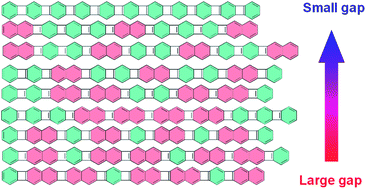Alternant conjugated oligomers with tunable and narrow HOMO–LUMO gaps as sustainable nanowires†
Abstract
Novel nanowire technologies encompass the use of metals and crystals with a high electric transport potential and superior charge-collection properties. However, nanowires built on metals such as cadmium, gallium-arsenide and similar alloys present serious environmental and health risks. The use of carbon is a far more environmentally friendly solution than heavy-metal based nanowires, and if arranged in a particular manner, it can provide excellent conductive properties that are applicable in nanowire technologies. Herein, we report an investigation into the particular carbon-based 4n/4n + 2 alternant resonance, which has the potential of becoming a key component for the design of novel and conductive nanomaterials, suitable for application in optoelectronics, nanoelectronics and microelectronics. A set of nine 4n/4n + 2 oligomers comprising in the range of 15–20 cyclic units (∼5 nm) were analyzed quantum mechanically. The results show that the number and type (4n or 4n + 2) of carbon-rings (cyclobutadiene, benzene and naphthalene) that constitute the oligomers, govern the HOMO–LUMO gaps with a statistical relevance of R2 = 0.919. Interestingly, we found that the sequence of the units played a central role in shaping the conductance of the 4n/4n + 2 oligomers, and that the sequencing of units in conductive carbon-based oligomers can be a potential future approach in tailoring the gaps of carbon-based conductive components for application in molecular electronics devices. An interesting relationship was also found between the symmetry and the homo- and heteromorphism of the LUMO elements with the HOMO–LUMO gaps, suggesting a pattern of continuity and wavefunction-symmetry across the LUMO orbitals of the 4n/4n + 2 systems to be a key-element determining the narrow gaps in the conductive carbon oligomers. In addition, population and electrostatic potential analysis showed that π-electron distribution over the oligomers is quite non-uniform. The electron delocalization behavior over the 4n and 4n + 2 rings was characterized by electron localization function, six-center bond order, and a striking linear relationship was found between the π-delocalization index of the C–C bonds and the HOMO–LUMO gaps (R2 = 0.988). The results presented herein introduce valuable approaches and data for the engineering of conductive materials to be applied in the field of nanoelectronics and microelectronics, and to relieve the development of nanowires from its dependence on expensive and rare metals.


 Please wait while we load your content...
Please wait while we load your content...